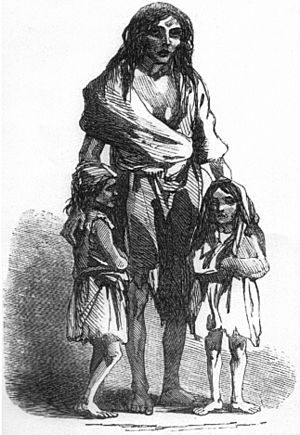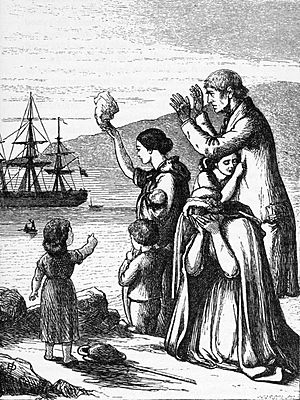Chronology of the Great Famine facts for kids
The Great Famine (also known as An Gorta Mór, meaning "The Great Hunger" in Irish) was a terrible time in Irish history. It lasted from late 1845 to 1852. During these years, Ireland's population dropped by about 20 to 25 percent. This means one in four or five people either died or left the country.
The main reason for the famine was a potato disease called late blight. This disease destroyed potato crops. Even though blight affected potatoes across Europe in the 1840s, Ireland suffered the most. This was because many Irish people relied only on potatoes for food. Other problems, like political and economic issues, made the situation much worse.
What Caused the Great Famine?
The Great Famine was a disaster caused by a plant disease and other problems.
The Potato Blight Arrives
1845: The Start of the Trouble
- August 1845: A potato disease was first reported in southern England. This was the first sign that the blight, which had already hit North America, had crossed the Atlantic Ocean.
- September 1845: The potato blight was reported in Ireland for the first time on September 13. Potato crops in Dublin suddenly started dying. People began to worry about what this would mean for Ireland.
- October 1845:
- As farmers started digging up their potatoes, terrible news came in. Many crops were completely ruined.
- The Prime Minister of Britain, Robert Peel, decided to act. He called an emergency meeting to discuss the problem.
- Peel also sent a group of scientists to Ireland. Their job was to study the potato blight and report on the conditions.
- During the emergency meeting, Peel suggested buying food for the areas that needed it most. He also wanted to get rid of the "Corn Laws."
What Were the Corn Laws?
The Corn Laws were rules that kept the price of grain grown in Britain very high. They added taxes to grain imported from other countries. This helped British farmers earn more money. However, it made bread and other foods very expensive for working-class people. Peel believed that if the Corn Laws were removed, it would allow cheaper food to be brought into Ireland. But many politicians disagreed with him.
- November 1845:
- Prime Minister Peel secretly ordered £100,000 worth of Indian corn (also known as maize) and cornmeal from America. This food was meant to be given out in Ireland.
- Scientists reported that half of Ireland's potato crop was already destroyed.
- A committee in Dublin confirmed that more than one-third of the potato crop was gone.
- Peel tried to convince his government to get rid of the Corn Laws, but he couldn't. He even resigned as Prime Minister for a short time.
The Famine Worsens
1846: Hunger Spreads
- The first deaths from hunger began in early 1846.
- Prime Minister Peel started a program to create public jobs in Ireland. This was meant to give people work and money to buy food.
- However, Peel had to resign in June 1846. A new government took over, led by Lord Russell.
- The new government believed in "laissez-faire" ideas. This meant they thought the market should solve problems on its own, without government help. So, they stopped the government food and relief programs.
- This left hundreds of thousands of people without work, money, or food. Even worse, grain continued to be sent out of Ireland to other countries.
- Private groups, like the Society of Friends (Quakers), tried to help. Eventually, the government restarted some relief work, but it was slow.
- The potato blight almost completely destroyed the 1846 crop. The famine became much worse. By December, over 300,000 people were working on public projects just to survive.
1847: The Year of Emigration
- In 1847, there were average potato harvests, but not enough potatoes were planted. This was because people had eaten their seed potatoes or couldn't afford new ones.
- Many people crowded into public work areas, which led to the spread of "famine fever" (diseases like typhus).
- A new law, called the Temporary Relief Act, was passed. It was known as the "Soup Kitchen Act." This law aimed to give cheap food directly to those who were starving.
- However, this relief system was stopped in September. After August 1847, a new system called the "Poor Law" was put in place. This meant local areas had to pay for their own relief efforts. This put a huge burden on poor areas, especially in western and southern Ireland.
- Many people decided to leave Ireland. They traveled on crowded, unsafe ships known as "coffin ships." Many died during these journeys.
- In December 1847, a law called the Crime and Outrage Bill was passed. This was because the British government was worried about a possible rebellion in Ireland. This law gave the government more power to control districts and limit who could own guns.
1848: Blight Returns and Uprising
- The potato blight returned in 1848.
- More people were forced out of their homes because they couldn't pay rent to their landlords.
- At its peak in July, almost 840,000 people were receiving outdoor relief (food or help given outside of workhouses).
- On July 29, a small uprising against the government happened. It was led by William Smith O'Brien. After a fight at "Widow McCormack's house" in Ballingarry, the leaders either fled or were sent away.
1849: More Sickness
- The potato crop failed again in 1849.
- A deadly disease called cholera spread, killing many people, including the famous Irish poet James Clarence Mangan.
The Famine Ends
1850: The Famine is Over
- The Great Famine officially ended in 1850.
1851: Counting the Cost
- By 1851, a census showed that Ireland's population had dropped to about 6.5 million people. This was a decrease of 1.6 million in just ten years.
- Historians believe that up to a million people died during the famine. Another million people left Ireland, mostly to America.
- The famine left a lasting feeling of sadness and anger among the Irish people towards the British government. Many blamed the government for not doing enough to help. The effects of the famine continued for many decades.
Images for kids
-
Skibbereen in 1847, painted by Cork artist James Mahony.




